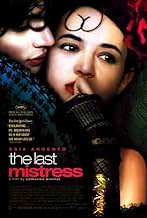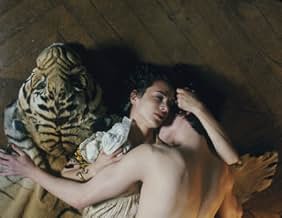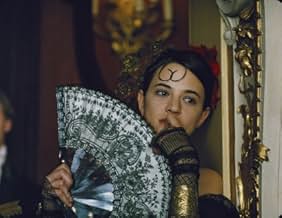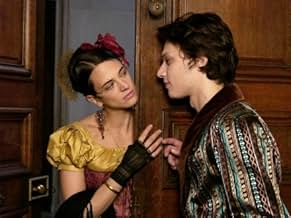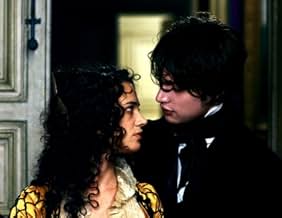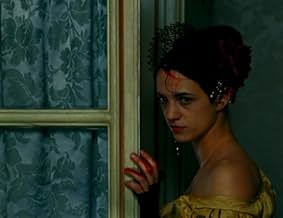IMDb-BEWERTUNG
6,2/10
3939
IHRE BEWERTUNG
Füge eine Handlung in deiner Sprache hinzuSecrets, rumors and betrayals surround the upcoming marriage between a young dissolute man and virtuous woman of the French aristocracy.Secrets, rumors and betrayals surround the upcoming marriage between a young dissolute man and virtuous woman of the French aristocracy.Secrets, rumors and betrayals surround the upcoming marriage between a young dissolute man and virtuous woman of the French aristocracy.
- Regie
- Drehbuch
- Hauptbesetzung
- Auszeichnungen
- 3 Nominierungen insgesamt
Empfohlene Bewertungen
Breillat's films are mostly small budget contemporary provocations with a feminist bent. This one, her twelfth, she says cost as much as ten previous ones and is a costume drama based on a controversial novel by Jules-Amédée Barbey d'Aurevilly (1808-1889). This is a bit confusing: the film begins by saying it's the century of Choderlos de Laclos (author of Dangerous Liaisons). but his famous work was written in 1782, and the action of d'Aurevilly's novel is set in 1835. The point is, the story is about the French aristocracy, and in the early nineteenth century its members still believed in and lived by the libertinism of Laclos.
In fact The Last Mistress (Une vieille maitresse) is a transitional story that links the two centuries and in a sense presents a romantic conception of the eighteenth century. Ryno de Marigny (beautiful newcomer Fu'ad Ait Aattou) is a high born young man who has squandered his wealth on his Spanish mistress, the willful Vellini (Asia Argento, in her element), with whom he's been involved for ten years. Allocine calls Ryno "a kind of romantic Valmont." But that's just it: there was nothing romantic about de Laclos' cruel and manipulative Valmont and Ryno is a new post-eighteenth-century conception of the eighteenth-century libertine that is titillated by his freedom but adds the emotional dressing of romantic passion. Breillat obviously loves this combination, is at home with it, and has given it deliriously appropriate treatment in this minor but beautiful, lush, and thoroughly enjoyable film.
The Breillat touch is perhaps most visible in the love-making scenes between Vellini and Ryno, in which there is much nudity and specificity of physical detail. Fu'ad Ait Aattou has pale skin and bigger lips than Asia Argento. By intention, both are androgynous; this is Breillat's conception of Choderlos de Laclos's and d'Aurevilly's libertines. The two actors are perfectly matched for this. Vellini is the aggressor; it is she who makes love with Ryno, using him like a lovely male statue made of alabaster. He is passionate like a romantic lover, however: that is, he's hung up on her forever, no matter what he tries. Early on, he fights a duel with her English husband and is wounded in the shoulder. The sex sequences are specific and fleshy as in no other costume drama, but Breillat is not creating an anachronistic work. As she explained in the NYFF press Q&A, she is passionate about the quality of her period detail and bought tons of lush materials and costumes. The dress, the jewelry, and the interiors are all completely authentic, and there is a rich color scheme in which red and green and yellow predominate. Without seeming over-glossy (it's not eye-candy like Sofia Coppola's Marie Antoinette), The Last Mistress is a pleasure to look at. It's also a pleasure to listen to, with its choice use of ornate and witty language. Oldtimer Michael Lonsdale as the gossipy Le vicomte de Prony particularly relishes his well-turned phrases.
As the story gets under way, Ryno has now found a wife, the beautiful young blonde noblewoman Hermangarde (Breillat regular Roxane Mesquida), and he's in love with her, and tired of Villini. Hermangarde's grandmother, the Marquise de Flers (non-actress Claude Sarraute, daughter of novelist Nathalie) is responsible for vetting Ryno, and in a lengthy sequence that's the heart of the film, he confesses to her everything about his relationship with Vellini. After much has been told (and shown on screen) in an amusing moment we see the Marquise reclining low in her seat: she is exhausted, but entranced. She wants to hear every detail. The Marquise is of course, of the older generation--a real Choderlos de Laclos lady. For her, the information that Ryno is a true libertine is proof that he is reliable, not an unknown quantity. And the cards are on the table. He'll do.
Rybno has every intention of having done with Vellini, and in a scene we've observed before his confession, he's made love with her one last time and they've said their adieus and adioses. Afrter his marriage, which we don't see, Ryno and Hermangarde live in a castle by the sea--so that he can avoid the temptations of Paris. Velllini waits four months, and then she appears. And once she is in front of Ryno, despite his professions of being fed up with her, he can't resist her.
There are several scenes in which Vellini draws blood from Ryno and licks it up: hints or Ms. Argento's father's films? Part of the New York Film Festival 2007. Three years after a stroke, Breillat is clearly in fine form--never better--and this is a long-awaited (by her) labor of love.
In fact The Last Mistress (Une vieille maitresse) is a transitional story that links the two centuries and in a sense presents a romantic conception of the eighteenth century. Ryno de Marigny (beautiful newcomer Fu'ad Ait Aattou) is a high born young man who has squandered his wealth on his Spanish mistress, the willful Vellini (Asia Argento, in her element), with whom he's been involved for ten years. Allocine calls Ryno "a kind of romantic Valmont." But that's just it: there was nothing romantic about de Laclos' cruel and manipulative Valmont and Ryno is a new post-eighteenth-century conception of the eighteenth-century libertine that is titillated by his freedom but adds the emotional dressing of romantic passion. Breillat obviously loves this combination, is at home with it, and has given it deliriously appropriate treatment in this minor but beautiful, lush, and thoroughly enjoyable film.
The Breillat touch is perhaps most visible in the love-making scenes between Vellini and Ryno, in which there is much nudity and specificity of physical detail. Fu'ad Ait Aattou has pale skin and bigger lips than Asia Argento. By intention, both are androgynous; this is Breillat's conception of Choderlos de Laclos's and d'Aurevilly's libertines. The two actors are perfectly matched for this. Vellini is the aggressor; it is she who makes love with Ryno, using him like a lovely male statue made of alabaster. He is passionate like a romantic lover, however: that is, he's hung up on her forever, no matter what he tries. Early on, he fights a duel with her English husband and is wounded in the shoulder. The sex sequences are specific and fleshy as in no other costume drama, but Breillat is not creating an anachronistic work. As she explained in the NYFF press Q&A, she is passionate about the quality of her period detail and bought tons of lush materials and costumes. The dress, the jewelry, and the interiors are all completely authentic, and there is a rich color scheme in which red and green and yellow predominate. Without seeming over-glossy (it's not eye-candy like Sofia Coppola's Marie Antoinette), The Last Mistress is a pleasure to look at. It's also a pleasure to listen to, with its choice use of ornate and witty language. Oldtimer Michael Lonsdale as the gossipy Le vicomte de Prony particularly relishes his well-turned phrases.
As the story gets under way, Ryno has now found a wife, the beautiful young blonde noblewoman Hermangarde (Breillat regular Roxane Mesquida), and he's in love with her, and tired of Villini. Hermangarde's grandmother, the Marquise de Flers (non-actress Claude Sarraute, daughter of novelist Nathalie) is responsible for vetting Ryno, and in a lengthy sequence that's the heart of the film, he confesses to her everything about his relationship with Vellini. After much has been told (and shown on screen) in an amusing moment we see the Marquise reclining low in her seat: she is exhausted, but entranced. She wants to hear every detail. The Marquise is of course, of the older generation--a real Choderlos de Laclos lady. For her, the information that Ryno is a true libertine is proof that he is reliable, not an unknown quantity. And the cards are on the table. He'll do.
Rybno has every intention of having done with Vellini, and in a scene we've observed before his confession, he's made love with her one last time and they've said their adieus and adioses. Afrter his marriage, which we don't see, Ryno and Hermangarde live in a castle by the sea--so that he can avoid the temptations of Paris. Velllini waits four months, and then she appears. And once she is in front of Ryno, despite his professions of being fed up with her, he can't resist her.
There are several scenes in which Vellini draws blood from Ryno and licks it up: hints or Ms. Argento's father's films? Part of the New York Film Festival 2007. Three years after a stroke, Breillat is clearly in fine form--never better--and this is a long-awaited (by her) labor of love.
Une vieille maîtresse (2007), adapted and directed by Catherine Breillat, was shown in the U.S. with the title, "The Last Mistress." This is a period film, set in early 19th-century France.
The basic plot is a love triangle--Fu'ad Ait Aattou plays the young aristocrat, Ryno de Marigny, who wants to marry the virtuous young woman, Hermangarde, played by the elegant Roxane Mesquida. Asia Argento plays Vellini, a highly sophisticated courtesan, with whom de Marigny has been having an affair for ten years.
The film is filled with beautiful women and lots of sex, but not much else. de Marigny doesn't seem all that desirable or interesting to me, and I didn't buy the plot line that Vellini simply couldn't let him out of her life. It's not that prostitutes can't fall in love, but it struck me as unlikely that this prostitute would fall in love--and stay in love--with this client.
We are supposed to understand that sexual values and attitudes are shifting at this time, and women are becoming liberated from the assumption that they can only be desired, but can't have desires themselves. Maybe so, but I think that justification was tacked on to a film whose raison d'etre is the display of lovely female bodies.
This movie was shown at the excellent Rochester High Falls International Film Festival. Most of the action takes place in drawing rooms and bedrooms, so the film will work well on DVD.
The basic plot is a love triangle--Fu'ad Ait Aattou plays the young aristocrat, Ryno de Marigny, who wants to marry the virtuous young woman, Hermangarde, played by the elegant Roxane Mesquida. Asia Argento plays Vellini, a highly sophisticated courtesan, with whom de Marigny has been having an affair for ten years.
The film is filled with beautiful women and lots of sex, but not much else. de Marigny doesn't seem all that desirable or interesting to me, and I didn't buy the plot line that Vellini simply couldn't let him out of her life. It's not that prostitutes can't fall in love, but it struck me as unlikely that this prostitute would fall in love--and stay in love--with this client.
We are supposed to understand that sexual values and attitudes are shifting at this time, and women are becoming liberated from the assumption that they can only be desired, but can't have desires themselves. Maybe so, but I think that justification was tacked on to a film whose raison d'etre is the display of lovely female bodies.
This movie was shown at the excellent Rochester High Falls International Film Festival. Most of the action takes place in drawing rooms and bedrooms, so the film will work well on DVD.
The Last Mistress, a film by Catherine Breillat, director of the hot-n-sexy (and probably X-rated if released in the 1970s) Romance, deals with the torn and frayed and wretched relationship between Vellini (Asia Argento), and Ryno de Marigny (first timer Fu'ad Ait Aattou), and how Ryno's mistress threatens his marriage to Hermandarde (Roxane Mesquida), granddaughter of a tough but very fair and reasonable old matriarch. Breillat's direction of the story, which is mostly told in flashback as the grandmother of her soon-to-be-grandson-in-law tells all about his very turbulent bond with Vellini, is sometimes a little dull and stodgy, and it drags in spots that it really should pick up in high gear.
But damn it all if it's not some absorbing times in the midst of a classic period setting among character we can relish in. Granted, Breillat likely cast Aattou for constantly having a 'sexy-man' look (somewhat akin, if you ask me, of a young Mick Jagger with ridiculously striking eyes and big lips). Argento, on the other hand, is cast perfectly, and for every bit that Aatou and Mesquida don't quite connect as husband and wife it's made up for by the total, hot connection between the real two leads. Argento is right at home with this twisted, damaged but alive and easily emotional creature, who has that tendency in French melodramas for tragedy at any moment just to get a rise. But she's also tender in surprising moments, and lets her soul bare completely in rough sex scenes (the craziest set in the desert following a very sudden death of a character), which par for Breillat are go-for-broke.
What the film may lack in really being a fully "modern" work- it feels like a lot of it is so stuck in the period novel setting that it's locked away, which maybe was the right choice- it's made up for by the stars' appeal and the drive of the torrid love affair that just won't go away. It's appealing, boring, and highly charged in equal measure.
But damn it all if it's not some absorbing times in the midst of a classic period setting among character we can relish in. Granted, Breillat likely cast Aattou for constantly having a 'sexy-man' look (somewhat akin, if you ask me, of a young Mick Jagger with ridiculously striking eyes and big lips). Argento, on the other hand, is cast perfectly, and for every bit that Aatou and Mesquida don't quite connect as husband and wife it's made up for by the total, hot connection between the real two leads. Argento is right at home with this twisted, damaged but alive and easily emotional creature, who has that tendency in French melodramas for tragedy at any moment just to get a rise. But she's also tender in surprising moments, and lets her soul bare completely in rough sex scenes (the craziest set in the desert following a very sudden death of a character), which par for Breillat are go-for-broke.
What the film may lack in really being a fully "modern" work- it feels like a lot of it is so stuck in the period novel setting that it's locked away, which maybe was the right choice- it's made up for by the stars' appeal and the drive of the torrid love affair that just won't go away. It's appealing, boring, and highly charged in equal measure.
Although I've seen several of them now, I still don't know if I actually LIKE Catherine Breillat films. Her films are a strange contradiction: On one hand, they contain a lot of pretty graphic sex and always feature some of the most attractive actresses in Europe (and this one with Asia Argento and Roxanne Mesquia is certainly no exception). On the other though, they are often very depressing and told with such a harsh feminist bent that they probably make most people (well, most men anyway)feel more like castrating themselves than getting turned on. ( I actually haven't even seen her most notorious film, "Fat Girl", but after the truly depressing experience that was the supposedly very similar "36 Fillete" I've never wanted to).
You would expect then given Breillat's typical misanthropic bent that when she made a French costume drama like this one, the liaisons would be even more dangerous and the intentions even crueler. This is actually a surprisingly soft-hearted film though where all the main characters are pretty likable and sympathetic (at least in some ways). The only typically harsh Breillat touch is a couple having frenzied sex next to the funeral pyre of their dead daughter. The basic story involves a handsome young rake, who is about to marry a beautiful young heiress (Mesquia) with the blessing of her jaded-but-wise grandmother (who, since this is set in 1835, is herself a battle-scarred veteran of the original pre-revolutionary "dangerous liaison" era). He is unable to give up his long-time mistress, however, a social-climbing Spanish divorcée (Argento) with whom he has had a passionate ten year love-hate relationship. All the acting is very good and the characters believable (although you do have to wonder why a 19th Spanish noblewoman would have a tattoo on her butt). My only real complaint was that it was about a half an hour too long and the climax was pretty anti-climactic.
If you like either French costume dramas or typical Catherine Breillat films, you may or may not like this, since it ends being very different than either. It's not too bad though.
You would expect then given Breillat's typical misanthropic bent that when she made a French costume drama like this one, the liaisons would be even more dangerous and the intentions even crueler. This is actually a surprisingly soft-hearted film though where all the main characters are pretty likable and sympathetic (at least in some ways). The only typically harsh Breillat touch is a couple having frenzied sex next to the funeral pyre of their dead daughter. The basic story involves a handsome young rake, who is about to marry a beautiful young heiress (Mesquia) with the blessing of her jaded-but-wise grandmother (who, since this is set in 1835, is herself a battle-scarred veteran of the original pre-revolutionary "dangerous liaison" era). He is unable to give up his long-time mistress, however, a social-climbing Spanish divorcée (Argento) with whom he has had a passionate ten year love-hate relationship. All the acting is very good and the characters believable (although you do have to wonder why a 19th Spanish noblewoman would have a tattoo on her butt). My only real complaint was that it was about a half an hour too long and the climax was pretty anti-climactic.
If you like either French costume dramas or typical Catherine Breillat films, you may or may not like this, since it ends being very different than either. It's not too bad though.
Une vieille maîtresse – The Last Mistress – CATCH IT (B) Based upon controversial French novel "Une vieille maîtresse/An old Mistress" by Jules Amédée Barbey d'Aurevilly. Just like most of the French movies The Last Mistress doesn't hesitate from sex, seduction and brutality of love. It's a story about a young rich French Ryno de Marigny who is ready to get married into a Nobel family. Just before getting married he confronts in front of his future rich wife's grandmother about his last old mistress of 10 years. The movie unfolds how Ryno falls head over heels for an older married woman, who is not even pretty or graceful. It's the rawness which attracts Ryno towards her, whom he first called an ugly nut. Fu'ad Aït Aattou a newcomer played Ryno with utmost honesty. He is divine and his falling for an Asia Argento's ambiguous character is questionable. But that's the whole point of love, lust and seduction when two unlikely people meet and ruin everything around them along with each other. Asia Argento is amazing, even though I saw her first in Marie Antoinette as French king's crazy mistress raised question of her action ability because she acted the same as she acted here. If I ignore that she was in tedious Marie Antoinette and Une vieille maîtresse release long before atrocious Marie Antoneitte. I actually loved her performance. There are many few actresses who can let them emotionally and physically open like that. You forget that it's the part of an act as it looks reality. Fu'ad Aït Aattou and Asia Argento's chemistry makes this a memorable venture. The long sex confrontation scenes are the proof how involved they are with the subject. Roxane Mesquida as Ryno's wife is stunning as always. Une vieille maîtresse is a controversial tale of lust, love and seduction. Overall, I enjoyed the movie even though I wanted the characters to be smart not so naïve and stupid, lost in sex, lust and seduction.
Wusstest du schon
- WissenswertesCatherine Breillat discovered Fu'ad Aït Aattou in a Paris café.
- PatzerWhile Ryno is descending the stairs at the opera, an Edgar Degas mural can be seen. Degas would have only just been born in this era.
- VerbindungenFeatured in Metropolis: Cannes 2007 - Special (2007)
Top-Auswahl
Melde dich zum Bewerten an und greife auf die Watchlist für personalisierte Empfehlungen zu.
Details
- Erscheinungsdatum
- Herkunftsländer
- Sprachen
- Auch bekannt als
- The Last Mistress
- Drehorte
- Île de Bréhat, Côtes-d'Armor, Frankreich(Moulin du Birlot: Vellini's house in Brittany)
- Produktionsfirmen
- Weitere beteiligte Unternehmen bei IMDbPro anzeigen
Box Office
- Budget
- 6.000.000 $ (geschätzt)
- Bruttoertrag in den USA und Kanada
- 785.671 $
- Eröffnungswochenende in den USA und in Kanada
- 33.554 $
- 29. Juni 2008
- Weltweiter Bruttoertrag
- 1.831.577 $
- Laufzeit
- 1 Std. 49 Min.(109 min)
- Farbe
- Sound-Mix
- Seitenverhältnis
- 1.85 : 1
Zu dieser Seite beitragen
Bearbeitung vorschlagen oder fehlenden Inhalt hinzufügen



